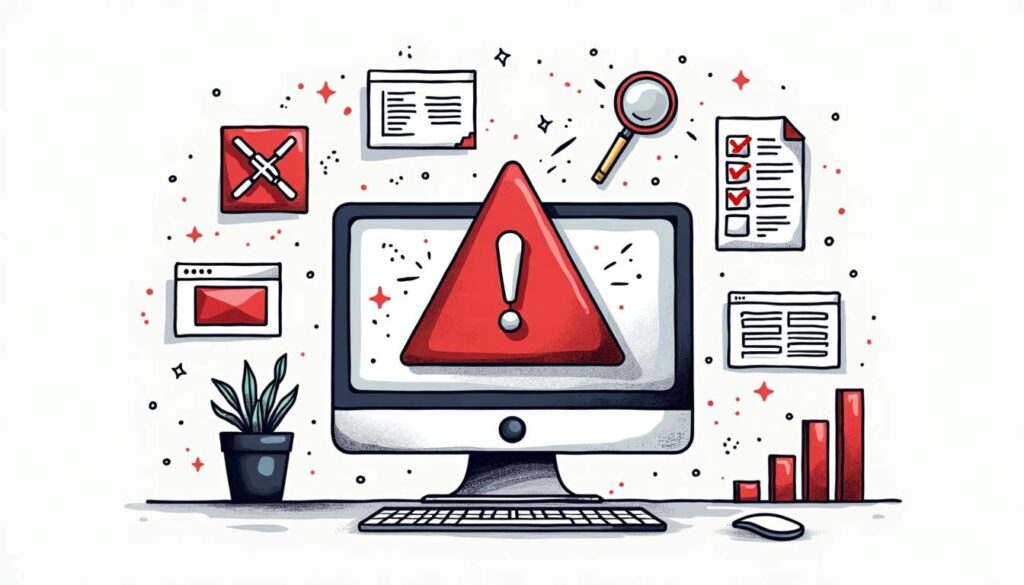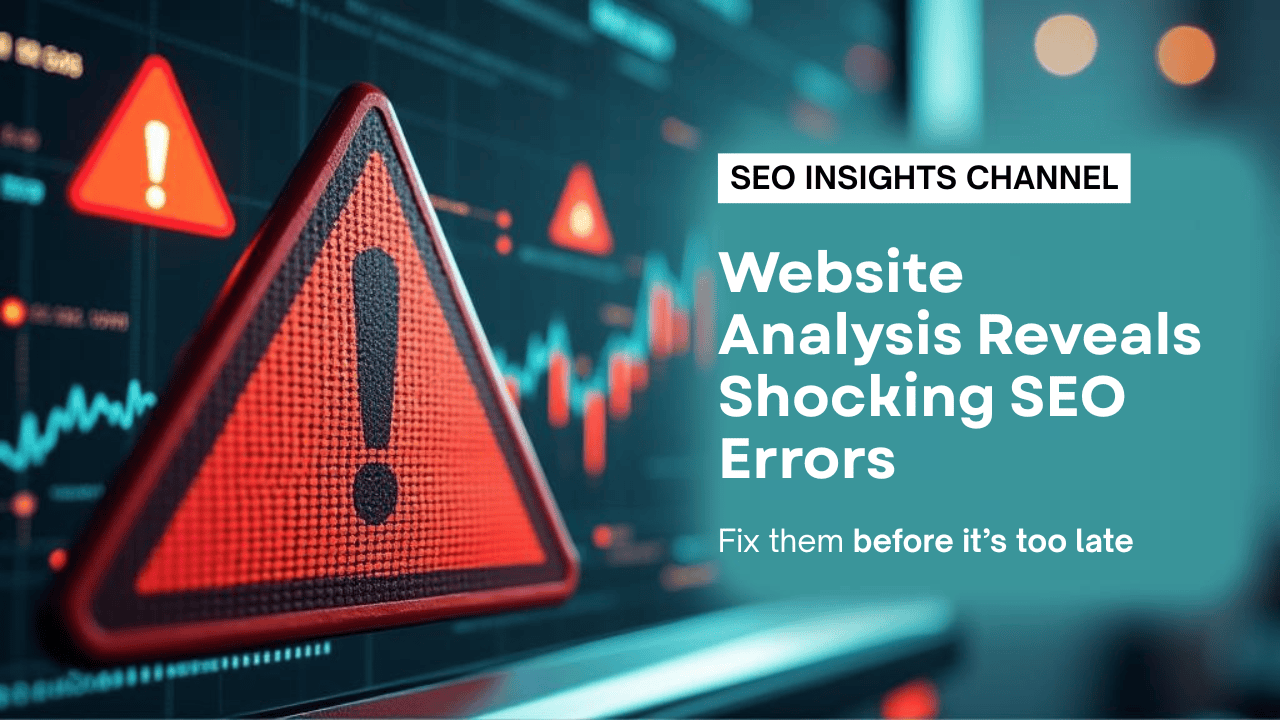Website Analysis Reveals Shocking SEO Errors—Fix Them Before It’s Too Late.
In a fierce competitive digital landscape, a website is not enough. To be really successful, your site must be adapted to the search engine, making sure that it arrives effectively to your target audience. However, recent broad websites analyzes show that many businesses are inadvertently reduced important SEO errors that severely obstruct their online visibility. These mistakes may reduce the lost traffic, low brand authority, and eventually, revenue.
This article dives deeply into the most common and stunning SEO errors exposed during the website audit, explains why they matter, and provides actionable solutions to fix them before too long. Whether you are the owner of a business, market, or web developer, understanding these disadvantages is necessary to recover your site’s search engine performance.
Why SEO Errors Are More Damaging Than You Think
SEO errors do not only affect your site’s ranking; They affect user experience, brand reliability and conversion rates. According to a 2023 study by Semrush, more than 60% of websites were analyzed, with at least one significant SEO error, which directly contributed to a 20% or more decline in organic traffic within six months.

Search engines such as Google use complex algorithms to evaluate websites. Even minor issues such as slow loading speed or duplicate materials can be punished or ignored your site. As a result, your competitors who maintain clean, customized websites get unfair benefits.
Ignoring SEO errors is the same for leaving money on the table. The sooner you identify these problems and solve, the better the better Serps (search engine result page) is likely to climb and attract qualified visitors.
In addition, the effects of SEO errors are just beyond the ranking. A website filled with technical issues may disappoint users, leading to high bounce rates and low engagement metrics. In fact, research indicates that the page load time may reduce the conversions of one-second in time to decrease by 7%. This means that not only you are losing potential customers, but you are also sending a message that your brand may not be reliable or professional. Users are likely to add a poor website experience with lack of quality in products or services introduced.
Additionally, SEO errors can obstruct your site’s ability to establish rights and reliableness in your niche. Search engines prioritize websites that provide valuable, relevant materials and a spontaneous user experience. If your site is prone to broken links, missing meta tags, or improper use of header tag, it sends a hint to the search engines that your site may not be a reliable source of information. This can result in low ranking and low visibility, making it difficult for potential customers to find your offerings in crowded digital marketplaces.
Top Shocking SEO Errors Discovered in Website Audits
1. Broken Links and 404 Errors
One of the most brightest SEO mistakes is a broken link and the presence of 404 error pages. These occur when the links point to the pages that are no longer present or have gone without proper redirection. Not only disappoint the broken link users, but they also indicate the search engines that your site is poorly maintained.
In the recent audit of over 1,000 websites, approximately 45% included broken internal or external links. This can cause a high boom rate and low crawl efficiency, as the search engine bots navigate dead ends to navigate waste time waste time.
How to fix: Use devices such as frogs or ahrefs to crawl your website and identify broken links. Apply 301 redirects to transferred pages, update or remove the old link, and monitor your site regularly to prevent future events.
Click to know more about SEO services for your business
2. Duplicate Content Issues
Duplicate content is silent kiler of any website SEO performance. This discovery confuses the engines to index and rank which version of a page. This can dilute your site rights and lead to ups and ransom in the ranking.
General reasons include the printer-friendly version of the pages, sessions IDs in the URL, and the content copied in several pages. Google’s John Muler has emphasized that duplicate material is not fined, it can significantly reduce your pages visibility.
How to fix: Apply a canonical tag to indicate the favorite version of a page. Use the URL parameters wisely and consider consolidating the same material. Audit your site regularly for duplicate materials using a tool such as copscap or cystiner.
3. Missing or Poorly Optimized Meta Tags
Meta titles and descriptions are critical for telling search engines and users what your page is about. Shockingly, many websites either have missing meta tags or use generic, non-descriptive text that fails to entice clicks.
A study by Backlinko found that pages with optimized meta descriptions receive up to 5.8% higher click-through rates. Conversely, missing or duplicated meta tags can cause search engines to auto-generate snippets that may not align with your content.
How to fix: Craft unique, keyword-rich meta titles and descriptions for each page. Keep titles under 60 characters and descriptions under 160 characters to avoid truncation in search results. Tools like Yoast SEO or Moz can guide you in optimizing these elements.
4. Slow Page Load Speeds
Page speed is a confirmed ranking factor and a major user experience. According to Google’s 2023 core web veils updates, websites loading within 2.5 seconds are favored in the search rankings.
Nevertheless, many sites still suffer from slow loading time due to uncontrolled images, excessive scripts, or poor hosting. A delay of just one second can lead to an increase of 32%, leaving potential customers.
How to fix: Compress images, take advantage of browser cashing, reduce JavaScript and CSS files, and consider upgrading your hosting plan. Use Google PageSpid Insights or GTMETRIX to analyze and improve your site speed.
5. Lack of Mobile Optimization
With more than 60% global web traffic from mobile devices, mobile adaptation is no longer optional. Websites that are not mobile friendly are suffering from poor ranking and high bounce rates.
General issues include universal designs, small fonts and buttons that are difficult to tap. Google’s mobile-first sequencing means that the mobile version of your site is used for ranking and sequencing, making mobile optimization important.
How to fix: Keep your website responsive, test your site on various devices, and use Google’s mobile-friendly test equipment to identify and solve mobile-purpose issues.
Advanced SEO Errors That Often Go Unnoticed
1. Improper Use of Robots.txt and Noindex Tags
Robots.txt files and noindex tag control how the search engines crawl and index your site. Misconfigurations can unknowingly prevent significant pages from being indexed, leading to significant decline in organic traffic.
For example, a general error is rejecting the entire site or important directions in a robot.
How to fix: Review your robots. The audit page with noindex tag is excluded from sequencing to ensure only irrelevant or duplicate content.
2. Poor Internal Linking Structure
Internal links help distribute the page authority on your website and guide users to related materials. A weak or inconsistent internal linking structure can limit the craze and ranking capacity of your pages.
Many sites fail to use generic anchor text such as “click here”, which do not provide a reference to search engines.
How to fix: Develop a strategic internal linking scheme that combines relevant pages using descriptive, keyword-rich anchor text. Tools such as Ahrefs and Semrush can help identify orphan pages and link opportunities.
3. Ignoring Structured Data and Schema Markup
The structured data search engine helps the engine better understand your content and can increase your listing with rich snipites, such as reviews, FAQs and Event details. Despite its benefits, many websites ignore to implement Schima Markup.
According to the 2024 brightage report, websites using structured data views a 20% increase in click-wealth rates.
How to fix: Use Google’s structured data markup helper or Schima.ORG to add the relevant scheme type to your pages. Copy your markup with the rich result test of Google to ensure proper implementation.
How to Conduct a Comprehensive SEO Audit
Identifying and fixing SEO errors requires a systematic approach. Here’s a step-by-step guide to conducting a thorough SEO audit:

Step 1: Crawl Your Website
Use tools like Screaming Frog, Sitebulb, or DeepCrawl to scan your entire website. These tools will reveal broken links, duplicate content, missing meta tags, and other technical issues.
Step 2: Analyze Site Performance
Check your site’s loading speed and Core Web Vitals using Google PageSpeed Insights and GTmetrix. Identify bottlenecks and prioritize fixes based on impact.
Step 3: Review Mobile Usability
Test your website’s mobile responsiveness with Google’s Mobile-Friendly Test and examine user behavior on mobile devices via Google Analytics.
Step 4: Examine On-Page SEO
Evaluate meta titles, descriptions, header tags, and content quality. Ensure keyword optimization without keyword stuffing and check for duplicate or thin content.
Step 5: Audit Backlinks and Internal Links
Use Ahrefs, Moz, or SEMrush to analyze your backlink profile and internal linking structure. Identify toxic links and opportunities to improve link equity distribution.
Step 6: Check Indexing and Crawlability
Review your robots.txt file, sitemap.xml, and use Google Search Console to monitor indexing status, crawl errors, and manual actions.
Preventive Measures and Best Practices to Avoid SEO Errors
It is important to fix the existing SEO errors, but it is equally important to stop them from recurring. Applying best practices ensures that your website remains customized and competitive.

- Regular audit: Schedule SEO performs quarterly audit to catch initial issues.
- Material rule: Keep a material calendar and guideline to avoid repetition and thin material.
- Training and awareness: SEOs your team on the importance of maintaining basics and site health.
- Automatic monitoring: Use devices such as Google Search Console alert and third-party monitoring to continuously track site health.
- Stay updated: SEO is constantly developing. Follow the industry news and algorithm updates to immediately customize your strategies.
Conclusion: Act Now Before SEO Errors Cost You More
The digital marketplace waits for anyone. SEO errors, especially shocking and often ignored, can quietly destroy the performance and business development of your website. By conducting broad audit, addressing important issues such as broken links, duplicate content, slow load time and mobile user, you can dramatically improve your search engine ranking and user experience.
Remember, SEO is not a once task, but a continuous commitment. Now fix these errors and install a strong foundation to flourish in the fast competitive online world. The cost of inactivity is very high – avoidable SEO mistakes are not allowed to keep your website back at any time.
Ready to Elevate Your SEO Game with FosterIdeaz?
Allow SEO errors to reduce your online success. At Fosterideaz, we are committed to transporting your business to the top of the Google rankings and running enough traffic on your website. Our experienced SEO experts are equipped with the latest strategies and techniques to fix your website for extreme performance. With services ranging from on-page optimization to comprehensive SEO consultancy, we are here to support all your digital marketing efforts. Take the first step towards increasing your online appearance and accelerating the development of your business. Start with FosterIdeaz Services today.

